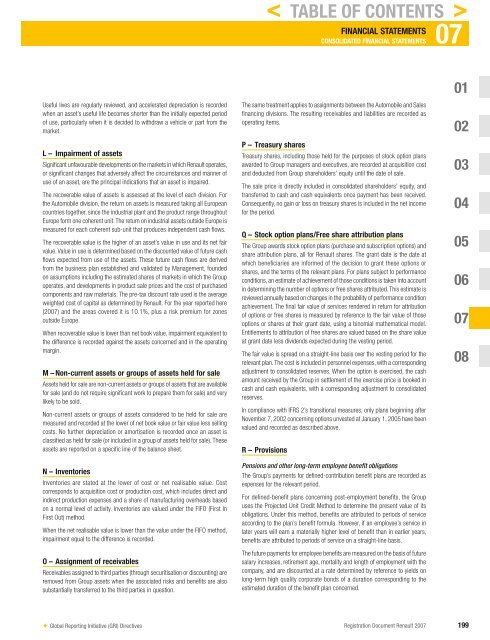2007 Interactive Registration Document - Renault
2007 Interactive Registration Document - Renault
2007 Interactive Registration Document - Renault
You also want an ePaper? Increase the reach of your titles
YUMPU automatically turns print PDFs into web optimized ePapers that Google loves.
Useful lives are regularly reviewed, and accelerated depreciation is recorded<br />
when an asset’s useful life becomes shorter than the initially expected period<br />
of use, particularly when it is decided to withdraw a vehicle or part from the<br />
market.<br />
L – Impairment of assets<br />
Signifi cant unfavourable developments on the markets in which <strong>Renault</strong> operates,<br />
or signifi cant changes that adversely affect the circumstances and manner of<br />
use of an asset, are the principal indications that an asset is impaired.<br />
The recoverable value of assets is assessed at the level of each division. For<br />
the Automobile division, the return on assets is measured taking all European<br />
countries together, since the industrial plant and the product range throughout<br />
Europe form one coherent unit. The return on industrial assets outside Europe is<br />
measured for each coherent sub-unit that produces independent cash fl ows.<br />
The recoverable value is the higher of an asset’s value in use and its net fair<br />
value. Value in use is determined based on the discounted value of future cash<br />
fl ows expected from use of the assets. These future cash fl ows are derived<br />
from the business plan established and validated by Management, founded<br />
on assumptions including the estimated shares of markets in which the Group<br />
operates, and developments in product sale prices and the cost of purchased<br />
components and raw materials. The pre-tax discount rate used is the average<br />
weighted cost of capital as determined by <strong>Renault</strong>. For the year reported here<br />
(<strong>2007</strong>) and the areas covered it is 10.1%, plus a risk premium for zones<br />
outside Europe.<br />
When recoverable value is lower than net book value, impairment equivalent to<br />
the difference is recorded against the assets concerned and in the operating<br />
margin.<br />
M – Non-current assets or groups of assets held for sale<br />
Assets held for sale are non-current assets or groups of assets that are available<br />
for sale (and do not require signifi cant work to prepare them for sale) and very<br />
likely to be sold.<br />
Non-current assets or groups of assets considered to be held for sale are<br />
measured and recorded at the lower of net book value or fair value less selling<br />
costs. No further depreciation or amortisation is recorded once an asset is<br />
classifi ed as held for sale (or included in a group of assets held for sale). These<br />
assets are reported on a specifi c line of the balance sheet.<br />
N – Inventories<br />
Inventories are stated at the lower of cost or net realisable value. Cost<br />
corresponds to acquisition cost or production cost, which includes direct and<br />
indirect production expenses and a share of manufacturing overheads based<br />
on a normal level of activity. Inventories are valued under the FIFO (First In<br />
First Out) method.<br />
When the net realisable value is lower than the value under the FIFO method,<br />
impairment equal to the difference is recorded.<br />
O – Assignment of receivables<br />
Receivables assigned to third parties (through securitisation or discounting) are<br />
removed from Group assets when the associated risks and benefi ts are also<br />
substantially transferred to the third parties in question.<br />
✦ Global Reporting Initiative (GRI) Directives<br />
FINANCIAL STATEMENTS 07<br />
CONSOLIDATED FINANCIAL STATEMENTS<br />
The same treatment applies to assignments between the Automobile and Sales<br />
fi nancing divisions. The resulting receivables and liabilities are recorded as<br />
operating items.<br />
P – Treasury shares<br />
Treasury shares, including those held for the purposes of stock option plans<br />
awarded to Group managers and executives, are recorded at acquisition cost<br />
and deducted from Group shareholders’ equity until the date of sale.<br />
T he sale price is directly included in consolidated shareholders’ equity, and<br />
transferred to cash and cash equivalents once payment has been received.<br />
Consequently, no gain or loss on treasury shares is included in the net income<br />
for the period.<br />
Q – Stock option plans/Free share attribution plans<br />
The Group awards stock option plans (purchase and subscription options) and<br />
share attribution plans, all for <strong>Renault</strong> shares. The grant date is the date at<br />
which benefi ciaries are informed of the decision to grant these options or<br />
shares, and the terms of the relevant plans. For plans subject to performance<br />
conditions, an estimate of achievement of those conditions is taken into account<br />
in determining the number of options or free shares attributed. This estimate is<br />
reviewed annually based on changes in the probability of performance condition<br />
achievement. The fi nal fair value of services rendered in return for attribution<br />
of options or free shares is measured by reference to the fair value of those<br />
options or shares at their grant date, using a binomial mathematical model.<br />
Entitlements to attribution of free shares are valued based on the share value<br />
at grant date less dividends expected during the vesting period.<br />
The fair value is spread on a straight-line basis over the vesting period for the<br />
relevant plan. The cost is included in personnel expenses, with a corresponding<br />
adjustment to consolidated reserves. When the option is exercised, the cash<br />
amount received by the Group in settlement of the exercise price is booked in<br />
cash and cash equivalents, with a corresponding adjustment to consolidated<br />
reserves.<br />
In compliance with IFRS 2’s transitional measures, only plans beginning after<br />
November 7, 2002 concerning options unvested at January 1, 2005 have been<br />
valued and recorded as described above.<br />
R – Provisions<br />
< TABLE OF CONTENTS ><br />
Pensions and other long-term employee benefit obligations<br />
The Group’s payments for defi ned-contribution benefi t plans are recorded as<br />
expenses for the relevant period.<br />
For defi ned-benefi t plans concerning post-employment benefi ts, the Group<br />
uses the Projected Unit Credit Method to determine the present value of its<br />
obligations. Under this method, benefi ts are attributed to periods of service<br />
according to the plan’s benefi t formula. However, if an employee’s service in<br />
later years will earn a materially higher level of benefi t than in earlier years,<br />
benefi ts are attributed to periods of service on a straight-line basis.<br />
The future payments for employee benefi ts are measured on the basis of future<br />
salary increases, retirement age, mortality and length of employment with the<br />
company, and are discounted at a rate determined by reference to yields on<br />
long-term high quality corporate bonds of a duration corresponding to the<br />
estimated duration of the benefi t plan concerned.<br />
01<br />
02<br />
03<br />
04<br />
05<br />
06<br />
07<br />
08<br />
<strong>Registration</strong> <strong>Document</strong> <strong>Renault</strong> <strong>2007</strong> 199




